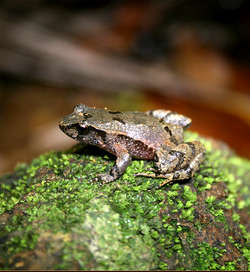Big effort focused on tiny tinker frog's future
 A Queensland team has embarked on an academic quest to save a tiny frog from extinction.
A Queensland team has embarked on an academic quest to save a tiny frog from extinction.
Researchers at Griffith University are working on a breeding program to boost numbers of the endangered tinker frog; a minuscule creature with a very distinctive voice.
Three of the six known species of tinker frogs have been destroyed, with previous studies suggesting the amphibian Chytrid fungus is to blame.
The tinker frog is named for its characteristic catch-phrase, as it makes a ‘tinkering’ sound like a steel spoon on a glass jar.
Griffith‘s Professor Jean-Marc Hero says the race is on to protect the petite pond-dweller.
“There are only six species - they are an ancient Gondwana group - and at least three of those are already gone,” Dr Hero said.
“We are looking to recover and support the species that are remaining.”
The program has so far produced a record number of tadpoles, according to Saskia Lafebre from the Currumbin Wildlife Sanctuary on the Gold Coast.
“We've got large numbers of eggs, large numbers of tadpoles and hopefully we can turn that in to large numbers of metamorphs,” she said.
The tinker is a little bit more private with its mating habits than other frogs. It lays its eggs underground, as it has no pigmentation to protect it from sunburn.
“It's quite an unusual frog it has unusual behaviour and we are very lucky to be finally very successful in breeding them,” Dr Hero said.
“It's very important that we learn how to breed these species in captivity so we can save them from extinction.”
The researchers are also investigating the deadly skin fungus Chytridiomycota, hoping to find a way of protecting new specimens.
“The fate of the animals is still yet to be determined because we are still struggling with what is the cause of the decline in these animals,” he said.
“It's hard to know at this stage where these frogs are first infected by the zoo spores of the lethal fungus that kills them, but it's certainly in water and probably most likely the tadpole stage.
“We have to be really careful before we re-release them into the wild that they are not infected with that disease.”








 Print
Print